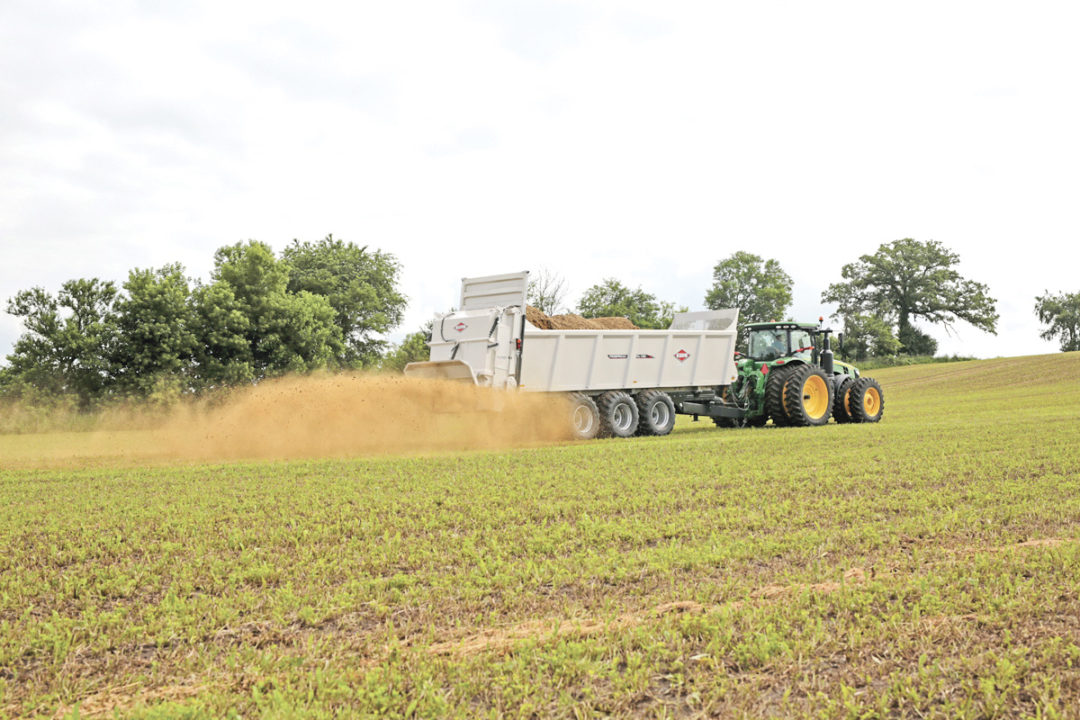To read this article in French, click here.
The saying “smells like money” when an individual smells manure could not be more accurate than at the present time. With fertilizer costs at record highs, livestock producers must be more cognizant of the byproducts of their animals. For many livestock farms, the utilization of manure has been a proven way to reduce fertilizer needs while increasing soil productivity. One of the main challenges with utilizing dry or semi-solid manure is capturing the information and quantifying it in a way that can be used for decision-making. Equipping manure spreaders with scales helps make tracking nutrients possible for most manure applications.
The need for tracking
First, no matter which fertilizer you choose for your farm or how you apply it, it is very important to keep the four R's of nutrient stewardship in mind. What are the four R's? As the name implies, four factors producers want to keep in mind include right source, right rate, right time and right place.
Whether from local government regulations or opposition from expanding residential communities, today’s livestock producers face challenges unique from prior generations. Fortunately, these obstacles are not impossible to overcome. Through utilization of the four R's, accountability, education and fastidious recordkeeping, producers can succeed in the public eye and financially through being good stewards of the land and managing nutrients appropriately.
Is my manure spreader scale ready?
The first step in managing nutrients appropriately, and tackling the “right rate” portion of the four R equation, is determining if your manure spreader is equipped with (or is able to be outfitted with) devices that can sense load in the spreader. These devices – often referred to as weigh bars, load cells or a variety of other terms – provide a signal sent on to a device that calculates the weight in the spreader. Weight sensors must be designed into the core of the spreader to be accurate; if a spreader is not designed with the ability to house weight sensors in the main frame, it will not be able to weigh material without significant modifications. Areas for potential weight sensor locations can be found in the spindles, hitch, box mounts or along the frame. With variability in designs from different manufacturers, contact your dealer with any questions regarding whether your spreader is or can be equipped with scales.
If the machine possesses the required components, the next step is deciding what type of scale system to implement. Manure spreader scale systems fall into three categories: basic, intermediate and advanced.
Basic system
A basic manure weighing system consists of weight sensors, a junction box and an indicator to give the operator a real-time readout of the weight in the spreader. The individual weight sensors transmit the respective weight to the junction box. The information, once consolidated in the junction box, will then be transferred to the indicator, where the operator will see a readout of total weight remaining. With this information, the individual will have a rudimentary idea of how much manure is being applied to a specific area.
Intermediate system
The intermediate weighing system is similar to a basic system, with the addition of a more complex indicator. An applicable manure spreader will still need weight sensors and a junction box but, in addition, a speed source and PTO speed sensor will also be necessary. This information is logged into the indicator, where application rate is displayed in real time based on ground speed, spread width and weight leaving the machine. This system requires the operator to adjust ground speed to achieve the desired application rate but will provide the operator with as-applied maps for decision-making and management plans.
Advanced system
The most advanced level of spreading dry or semi-solid manure offers the capability to upload prescription maps for variable-rate spreading, and record and export as-applied data that can be uploaded into precision ag management systems. An advanced manure weighing system consists of weight sensors, junction box and an indicator, but further includes speed sensors for both the tractor and apron chain, a rate controller and a pulse width modulation (PWM) valve for controlling oil flow. This system allows the operator infinite adjustments by changing one or both speed variables for desired management zones or allowing the machine to adjust on its own in accordance with parameters provided by the operator.
Selecting a scale system
All three scale options listed here (basic, intermediate and advanced) provide a measure of how much product was applied to the field. However, individuals must determine what level of nutrient tracking is best suited for their operations.
The basic weighing system is best suited for customers looking to display the amount of weight in the manure spreader on a scale indicator. The intermediate level will allow the operator to visually see how much product is being applied via an indicator and provide as-applied maps. The advanced system takes nutrient tracking even further and offers the capability to upload prescription maps for variable-rate spreading on identified management zones.
Tracking manure spreading rates allows producers to quantify applied nutrients and ultimately help make the most of their operation’s manure.






